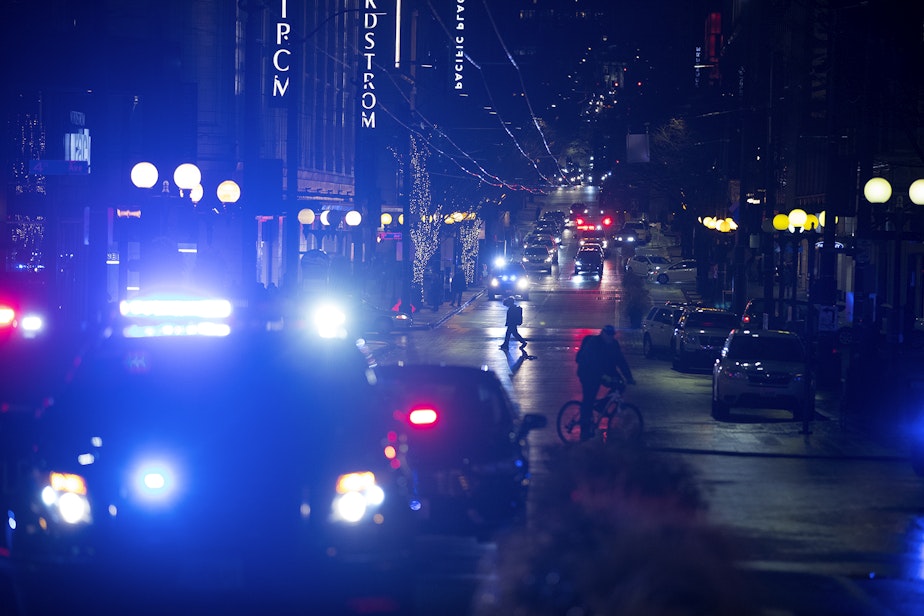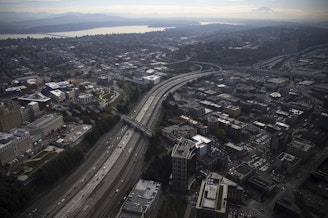Third & Pine in Seattle, corner of a concern

It’s a corner of sharp contrasts, and it’s at the center of concerns about the state of Seattle's community.
The Macy’s building at the corner is preparing to close as the company struggles (Macy's once took over the grand old home of the Bon Marché). Upstairs in the building, Amazon is the new tenant. Its guards are standing outside.
Around them are office workers, security guards and police officers, as well as people mired in struggle. A man panhandles holding a cardboard sign. Another shouts at the top of his lungs.
In the heyday of the department store, there wouldn't have been such a gap between the glamour inside and the hardscape outside. It's something Aparna Shridhar notices. She moved to Seattle last year and settled downtown.
“I was really shocked to see this kind of problem here, you know homelessness and drugs…it’s really out of balance,” Shridhar said.
Chances are, if you are going downtown, you will pass through Third and Pine. It is the convergence zone where office workers meet shoppers and people who live downtown.
Sponsored
Third Avenue is also downtown’s bus corridor. Nordstrom’s Seattle flagship store is nearby. Westlake Park. The Downtown Seattle Association has been working to make this area welcoming and safe for years.
Last month though, a shootout at the McDonald's here left one dead and seven injured. In the shooting’s aftermath, people said they felt shaken. Others talked openly about how the extreme poverty that is visible on the streets of downtown – as well as the violent undercurrent surrounding the McDonald’s. For years, there’s been an evening drug market around here.
“I find myself less enthused to come downtown,” said David Carey, who works at an office nearby. Working at home more frequently.”
Now there are police officers on most corners. Also: private security guards as people who work to keep order for the Downtown Seattle Association.
But it’s difficult, frustrating and sometimes dangerous work. Mynique Williams, a security guard at Westlake Park, says often she can’t believe the kind of difficulty she has doing it.
Sponsored
The other day a man was dropping his pants, yelling and stabbing himself with needles, she recalls. Williams said the man was exposing himself while there were children nearby. She had trouble keeping clothes on the man and more trouble getting help from police. Eventually, help arrived. Policing’s struggles are also part of the story of this corner.
“I think there needs some consequence to behavior. The police have struggled over the last 10 years,” said Dave Willard, vice president of Clean, Safe and Outreach Operations for the Downtown Seattle Association. He runs the DSA's platoon of cleaners and security people.
One significant problem occurs during the evening commute. At 5 p.m. the offices start to clear out and many security people head home. That's around when the drug trade picks up here.
Willard says it happens while commuters wait for their buses, and that is obscuring the drug activity that is happening.
“There are just too many of them, it’s like a duck blind out there,” he said. “When people can just stand there and say they are waiting for the bus but really be engaged in the whole drug culture out there.”
Sponsored
Addressing this problem is a critical part of making downtown a living place for everyone. But it’s also a huge challenge.
The Downtown Seattle Association has multiple proposals to reconfigure bus travel through downtown so that fewer commuters must wait at Third and Pine. However, many of these ideas require money – while King County Metro continues to invest in improving transit along Third Avenue.
The organization Feet First, which advocates for foot travel over car commuting, is a critic of the Downtown Association’s proposals. It argues that buses and commuters are not the root cause of the drug market problems at Third and Pine, so transit should not have to move to improve the situation.
At Seattle's corner of concern, solutions to the drug culture, street disorder and deep poverty remain elusive, even as the city's wealth and population grow on.



